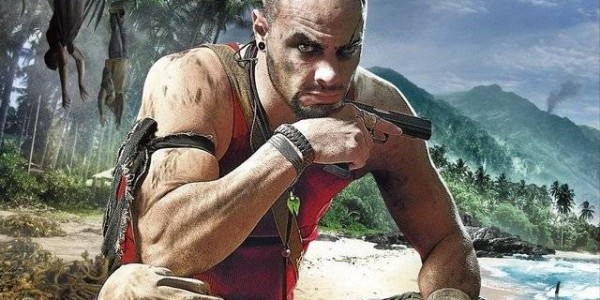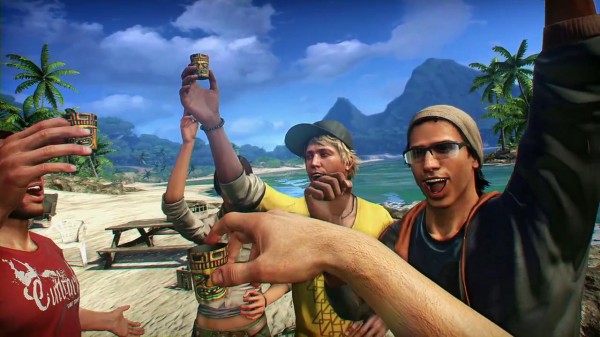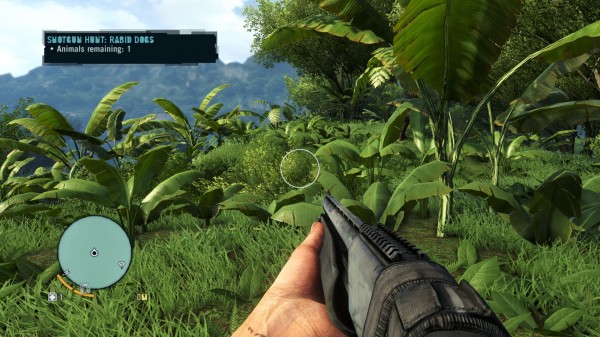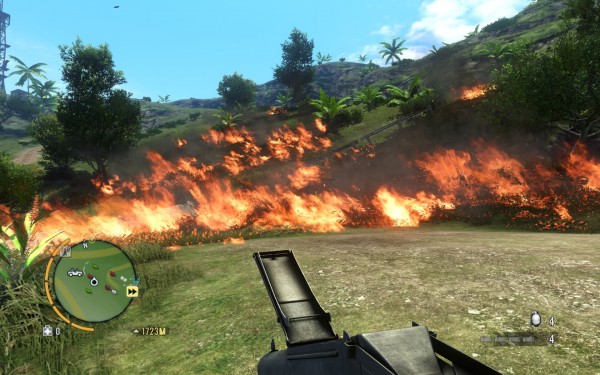It’s kill or be killed in Far Cry 3‘s world. Viscous animals and psychopathic villains alike pose a threat to the player. In order to fight back, one must hone their survival skills, acclimate to the tropical island, and maybe bring a flamethrower along – that never hurts. The staggering amount of content in Far Cry 3 captures the best part of open-world games in a user friendly way that was sorely missed in the series’ predecessor. But what distinguishes Far Cry 3 as one of the best games of the year is its careful balance between a world of realism and a virtual playpen for players to unleash mayhem. Danger lurks around every corner, but not once do I feel completely unprepared for what lies ahead.
With the tropical island acting as a foreign environment to both the player and protagonist, the potential for a riveting narrative in which some kind of attachment establishes itself between the two is huge. Unfortunately, Far Cry 3 squanders this opportunity with its abundance of unlikable characters, including protagonist Jason Brody. M.I.A’s “Paper Planes” blares from the speakers as Brody and company live it up on what seems like a picturesque vacation spot. In just these few brief opening moments the characters are painted as stereotypically rich and entitled brats who have no clue how cruel the outside world can be. Priorities change as Brody’s friends are captured, though, and a naive young man suddenly becomes a bloodthirsty warrior… at least that’s the story Ubisoft attempts to sell.
The transformation in Brody is anything but believable. He essentially loses his moral compass and gains a thirst for blood after a handful of firefights and an almost complete lack of interaction with his friends. He saves them, moves on, and repeats the process throughout the whole game. Ultimately, I did not care about Brody or his friends. Instead, I found far more interest in the bad guys, especially Vaas. This is the kind of over-the-top villain I’d love to see in more games, and actor Michael Mando completely loses himself in the role. I actually wish there had been an even stronger focus on Vaas to help compensate for the lack of redeeming characters on the opposite end of the spectrum. Despite all of these complaints I find myself unable to completely discredit Far Cry 3‘s narrative. Things get weird and explanations amount to crazed drug trips that only confuse the player even more. And yet I find myself amused by the absurdity of it all. Others may not share that view, but by the time the credits rolled I couldn’t help but laugh to myself after thinking back on the events of the game.
But to be completely honest, I didn’t go into Far Cry 3 expecting to care much about the story. GamerNode’s own pick for 2011 GOTY, Skyrim, was a game I enjoyed immensely irrespective of the less-than-thrilling narrative. In an open-world game like this, the aspects that matter most are the world itself and the activities that make up that world. In that sense, Far Cry 3 fires on all cylinders.
The most impressive aspect of the game’s tropical island is its reliance on realism in the form of systems that act independently of the player. Animals hunt each other, humans hunt animals, and cars break down on the side of the road. These are just a few examples of external events I encountered on my way to the next side mission or enemy outpost. But once the player inserts him or herself in that world, the emphasis on survival kicks in. Hunting is not merely an activity to help kill time or gain experience, it’s a necessary to avoid falling prey to the dangers of the deceptively beautiful vistas that make up Far Cry 3‘s world. By hunting, players gain materials to help craft pouches, which in turn allow for increased carrying limits. Good luck getting through the game with just one or two guns or a few syringes. Trust me, those syringes come in handy.
Far Cry 3 promotes survival instincts as much as it does experimentation in a virtual sandbox. That concept at its most basic form concerns the weapon variety. There are all kinds of tools at the player’s disposal, from high-powered sniper rifles to Molotov cocktails. Usually in games like this I find the few weapons I enjoy most and stick with them for the duration of the campaign. In Far Cry 3 I wanted to try each new weapon because they were all fun to use. I even found pleasure in shooting the bow and arrow despite my terrible skills with that weapon. The push toward experimentation also extends into the game’s abundance of activities, including such polar opposites as time trial races and scoreboard-centric combat challenges. By far the most critical of these activities is the scaling of radio towers. Think of the viewpoints in Assassin’s Creed, but from a first-person perspective. And by some miracle, Ubisoft managed to craft first-person platforming sections that are not absolutely terrible. In fact, the last few radio towers feature light puzzle elements with diverging paths – the last one in particular took me a bit longer to figure out. Ascending these radio towers reveals sections of the map and also unlocks free weapons in the game’s stores.
The other important side activity is the liberation of enemy outposts – by far my favorite activity in the whole game. By liberating these areas, players gain access to new fast-travel spots. Each outpost houses numerous enemies, from heavy flamethrower guards to deadly snipers. The player must survey the area, tag enemies, and then plan a course of action. The outposts became like miniature sandboxes for me to try out different tactics and weapons. Do I shoot all of the alarms with my silenced sniper rifle to prevent enemy reinforcements and then charge in, action-movie style? Or do to I take the stealth approach, stab all enemies in the back, and go for the lucrative experience bonus awarded for not alarming any enemies? That’s the kind of player choice I can get behind.
Speaking of experience, a leveling system is also included to further empower the player. With each new level, tattoos can be acquired that correlate with specific skills. There are three separate skill trees to consider, but in actuality it’s not a deep or complex system. By the end of the campaign I had acquired every skill in the game without much trouble. On the plus side, the skills themselves are often very useful and/or just plain awesome to perform. My personal favorite involved stabbing an enemy in the back, cooking his grenade, and then throwing him into a group of his friends only to watch the glorious explosion.
That feeling of glee washed away when I tried Far Cry 3‘s multiplayer component, which includes both competitive and cooperative modes. The competitive multiplayer is exactly what I’d expect from any modern FPS (typical modes, progression system, etc), while the cooperative missions are brutally difficult for a group of less than four. Far Cry 3‘s strengths don’t involve only shooting mechanics, so to take away the huge environment and the wide variety of activities is to take away what makes the core experience so great. Luckily, there is more than enough content in the single-player campaign for those who want to ignore the game’s merely serviceable multiplayer offering.
In the end I can forgive the narrative and multiplayer mistakes because the world Ubisoft has created in Far Cry 3 is so much fun to explore. To my surprise, tedium did not set in at any point – in the waning hours I still enjoyed the driving missions, the liberation of enemy outposts, and all of the other activities I took part in. I also loved the fact that despite all of my upgrades and my badass weaponry I could still be mauled by a tiger on my way to the car. The joys of a virtual ecosystem.





















